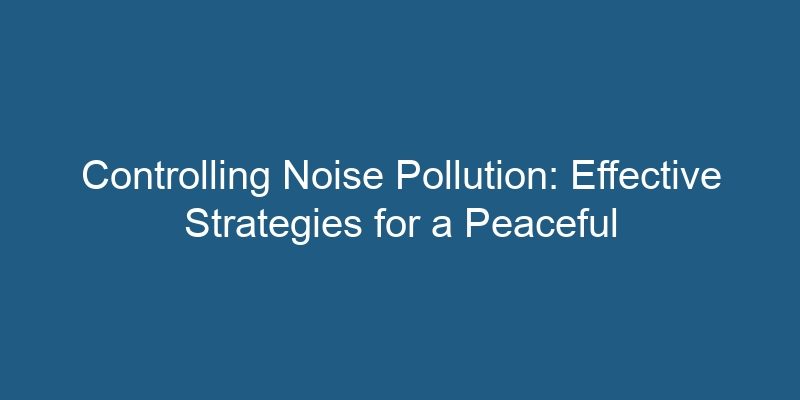Noise pollution is a growing concern in our modern society, affecting the quality of life for millions of people worldwide. Whether it’s traffic noise, construction sites, loud music, or industrial machinery, excessive noise can have detrimental effects on our physical and mental well-being. In this article, we will explore various strategies and techniques to control and mitigate noise pollution, creating a more tranquil living environment.
- 1. Understanding Noise Pollution
- 1.1 Sources of Noise Pollution
- 1.2 Impacts of Noise Pollution
- 1.3 Legal Regulations
- 2. Noise Control Measures
- 2.1 Noise Barriers and Soundproofing
- 2.2 Traffic Management
- 2.3 Green Spaces and Urban Planning
- 2.4 Noise Reduction in Construction and Industrial Sites
- 2.5 Noise Control in Public Spaces
- 3. Individual Actions to Reduce Noise Pollution
- 3.1 Noise-Canceling Headphones
- 3.2 Limiting Noise-Producing Activities
- 3.3 Insulating Living Spaces
- 3.4 Promoting Noise Awareness
- 4. Conclusion
1. Understanding Noise Pollution
Noise pollution refers to the excessive and unwanted sound that disrupts the natural balance of the environment. It is measured in decibels (dB), with prolonged exposure to high decibel levels posing significant health risks. To effectively control noise pollution, it’s crucial to comprehend its sources, impacts, and legal regulations surrounding noise levels.
1.1 Sources of Noise Pollution
Noise pollution can originate from various sources, including:
- Transportation (road, air, rail, and maritime)
- Construction and industrial activities
- Human activities (loud music, parties, events)
- Machinery and equipment
1.2 Impacts of Noise Pollution
The effects of noise pollution can be far-reaching and detrimental to our health. Some common impacts include:
- Hearing loss and damage
- Sleep disturbances and insomnia
- Increased stress levels
- Impaired concentration and productivity
- Cardiovascular problems
1.3 Legal Regulations
Many countries have implemented legal regulations to control noise pollution. These regulations often specify permissible noise levels for different areas, times of day, and types of activities. Familiarizing yourself with local noise control laws can help ensure compliance and mitigate noise pollution effectively.
2. Noise Control Measures
Controlling noise pollution requires a multi-faceted approach, combining engineering solutions, urban planning, and individual actions. Below are some effective noise control measures:
2.1 Noise Barriers and Soundproofing
Noise barriers, such as walls and fences, can effectively attenuate sound waves, reducing the impact of noise pollution. Soundproofing techniques, such as installing double-pane windows, insulation, and acoustic panels, can help create a quieter indoor environment.
2.2 Traffic Management
Managing traffic flow through various strategies, such as implementing speed limits, traffic calming measures, and intelligent transportation systems, can significantly reduce noise pollution caused by vehicles.
2.3 Green Spaces and Urban Planning
Integrating green spaces into urban areas can act as natural buffers, absorbing and deflecting sound waves. Effective urban planning, including zoning regulations and land use planning, can help separate noisy activities from residential areas, reducing noise exposure.
2.4 Noise Reduction in Construction and Industrial Sites
Implementing noise reduction measures, such as using quieter machinery, sound barriers, and limiting construction activities during sensitive hours, can minimize noise pollution from construction and industrial sites.
2.5 Noise Control in Public Spaces
Public spaces, such as parks, recreational areas, and shopping centers, should be designed with noise control in mind. Installing sound-absorbing materials, landscape elements, and regulating sound-emitting activities can contribute to a quieter environment.
3. Individual Actions to Reduce Noise Pollution
While collective efforts and regulations play a significant role in controlling noise pollution, individuals can also contribute to a quieter environment through simple actions:
3.1 Noise-Canceling Headphones
Investing in noise-canceling headphones can help block out external noise, creating a peaceful auditory experience in noisy environments.
3.2 Limiting Noise-Producing Activities
Avoiding excessive use of loud music, home appliances, and power tools, especially during late hours, can help maintain a quieter living environment for oneself and neighbors.
3.3 Insulating Living Spaces
Improving insulation in homes by sealing gaps, using thick curtains, and installing carpets can help reduce the penetration of external noise into living spaces.
3.4 Promoting Noise Awareness
Creating awareness about the detrimental effects of noise pollution and educating others about noise control measures can encourage a collective effort towards a quieter and healthier environment.
4. Conclusion
Noise pollution is a significant challenge in our modern world, impacting our well-being and quality of life. By understanding the sources, impacts, and legal regulations surrounding noise pollution, as well as implementing effective noise control measures and individual actions, we can collectively create a more peaceful and harmonious living environment for everyone.

